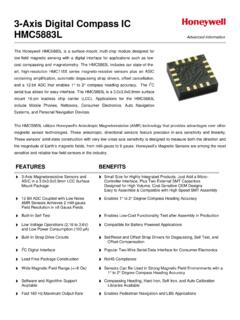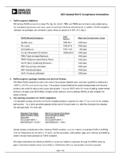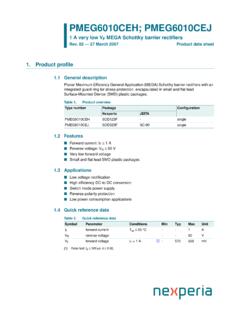Transcription of Best Practices Reflow Profiling for Lead-Free SMT Assembly ...
1 Indium Corporation Tech PaperFrom One Engineer To Another 1 Authored by: Ed Briggs and Ronald C. Lasky, , Download article Share with a friendA QR (quick response) code contains encoded data. When scanned with a smart phone s camera (via a QR reader application), it will take you to a specific URL or text Practices Reflow Profiling for Lead-Free SMT AssemblyABSTRACTThe combination of higher Lead-Free process temperatures, smaller print deposits, and temperature restraints on electrical components has created difficult challenges in optimizing the Reflow process.
2 Not only are the electronic components and the PWB at risk, but the ability to achieve a robust solder joint becomes difficult, especially if the PCB is thermally massive. In addition, the constant miniaturization of electronic components, hence smaller solder paste deposits, may require the use of smaller particle-sized powders. Both the small solder paste deposits and small particle size result in a large surface area-to-volume ratio that challenges the solder paste s flux to effectively perform its fluxing action. The possible resulting surface oxidation can lead to voiding, graping, head-in-pillow, and other defects.
3 Smaller components are also more susceptible to tombstoning and defects related to solder paste paper is a summary of best Practices in optimizing the Reflow process to meet these challenges of higher Reflow temperatures, smaller print deposits, decreased powder particle size, and their affect on the Reflow process. It also discusses trouble-shooting of the most common defects in Lead-Free Reflow , such as tombstoning, solder beading/balling, residue discoloration, voiding, graping, and words: solder defects, Reflow profile, tombstone, solder beads, solder balls, voids, head-in-pillow, introduction of higher Lead-Free process temperatures and a reduction in solder paste deposit volumes require narrower process windows to optimize the Reflow profile.
4 Not only are the electronics components and the PWB at risk due to the higher Reflow temperatures associated with Lead-Free processes, the components themselves can restrict the peak temperature that the process can use, making it difficult to achieve a robust solder joint, especially if the PCB is thermally massive. Decreased pad size might also require the solder paste to have solder powder with smaller particle diameters. Both the small solder paste deposits and smaller particle size result in a large surface area-to-volume ratio Form no. 9 8 675Ed briggsemail: Full biography: Ed Briggs, Technical Support Engineer, Indium Corporation, is an SMTA-certified engineer and has earned a Six-Sigma Green Belt Certification from Dartmouth College for demonstrated proficiency in developing and executing design experiments to support continuous process Corporation Tech PaperFrom One Engineer To Another 2that challenges the solder paste s flux to effectively perform its fluxing action.
5 The resulting surface oxide can lead to a number of solder defects such as voiding, beading/balling, graping, and head-in-pillow. This paper will discuss techniques to optimize the Reflow profile to minimize such of ProfilesThe two most common types of Reflow profiles are the ramp-to-peak profile, also called ramp-to-spike or tent profile (see Figure 1) and the soak profile, or ramp/soak/spike profile (see Figure 2). A ramp-to-peak profile is a linear ramp to the peak (max) temperature. A soak profile displays some plateau within a limited temperature range, before the alloy StagesThe SMT Reflow profile can be broken down into 4 phases or regions: preheat, pre- Reflow , Reflow , and preheat phase preconditions the PCB Assembly prior to actual Reflow , removing flux volatiles and reducing thermal shock to the PCB ramp rate is the slope of temperature versus time for the heating portion of the Reflow profile.
6 It originates at ambient temperature and ends at the peak temperature. The rate is defined primarily in the preheat phase. A ramp rate of C/second is normal and is largely affected by the Reflow oven belt speed and the -T (delta-T) between heating zones ( T of <40 C is recommended between heating zones). Typically the instantaneous ramp rate will vary as seen in Figure 3. Hence, the maximum ramp rate of C/second, reported in Figure 3, is somewhat meaningless. Most important is the average ramp rate, which is the pre- Reflow phase, the flux activator (or activator package) removes any existing surface oxide from the component leads and PWB pad finishes, as well as any oxide on the powder particles within the solder paste itself, preparing the surfaces to be joined during temperature soak, if incorporated, is normally found in this phase.
7 The soak temperature is controlled within a RONALD C. LASKy, PhD, PERonald C. Lasky, , Senior Technologist, Indium Corporation, holder of the prestigious SMTA Founder s Award, is a world-renown process expert and an Instructional Professor at Dartmouth College. He has over 25 years of experience in electronics and optoelectronic packaging and Assembly . He has authored or edited five books and numerous technical papers and holds several patent : biography: corporate/bio/Figure 1 - Ramp-to-peak Reflow 2 - Ramp/soak/spike Reflow Corporation Tech PaperFrom One Engineer To Another 3tight range (see Figure 2) for a specified time.
8 This plateau in the Reflow profile allows the thermal gradient across the PCB to equilibrate prior to Reflow . In this way, the entire Assembly sees nearly the same Reflow conditions (peak temperature and time-above-liquidus) to form consistent solder bonds. Any potential thermal gradient increases as the physical size of the PCB and the diversity of component size increase, so for such large PCBs a soak profile is usually helpful to achieve successful profiles are also used to minimize voiding when assembling such components as BGA (ball grid array), LGA (land grid array), SGA ( solder grid array), and QFN (quad flat pack, no leads)
9 , purging the solder paste of volatile materials, decreasing flux out-gassing, and diminishing the amount/size of voids entrapped in the solder joint upon actual Reflow of the solder alloy involves the creation of a mechanical and electrical bond through the formation of tin-copper forming optimum intermetallics, two critical parameters are involved in the Reflow phase: peak temperature and TAL (time-above-liquidus). The peak temperature is generally 20-30 C above the liquidus temperature of the alloy and the TAL is typically 30-90 seconds in order to form effective cooling phase determines the grain structure of the solder joint.
10 A fine grain structure provides the most reliable mechanical bond. To achieve this structure, a rapid cooling rate as the solder transitions from liquid (liquidus) to solid (solidus) is needed (the first ~50 C of cooling). The limiting factor for the maximum cooling rate is the stress that is exerted on the solder joint if the rate is too fast. This thermal stress, depending on the differences in CTE (coefficient of thermal expansion) of the joining surfaces, can fracture or tear the solder joint. The greater the difference in CTE of the joining materials and the cooling rate, the greater the thermal stress generated.











